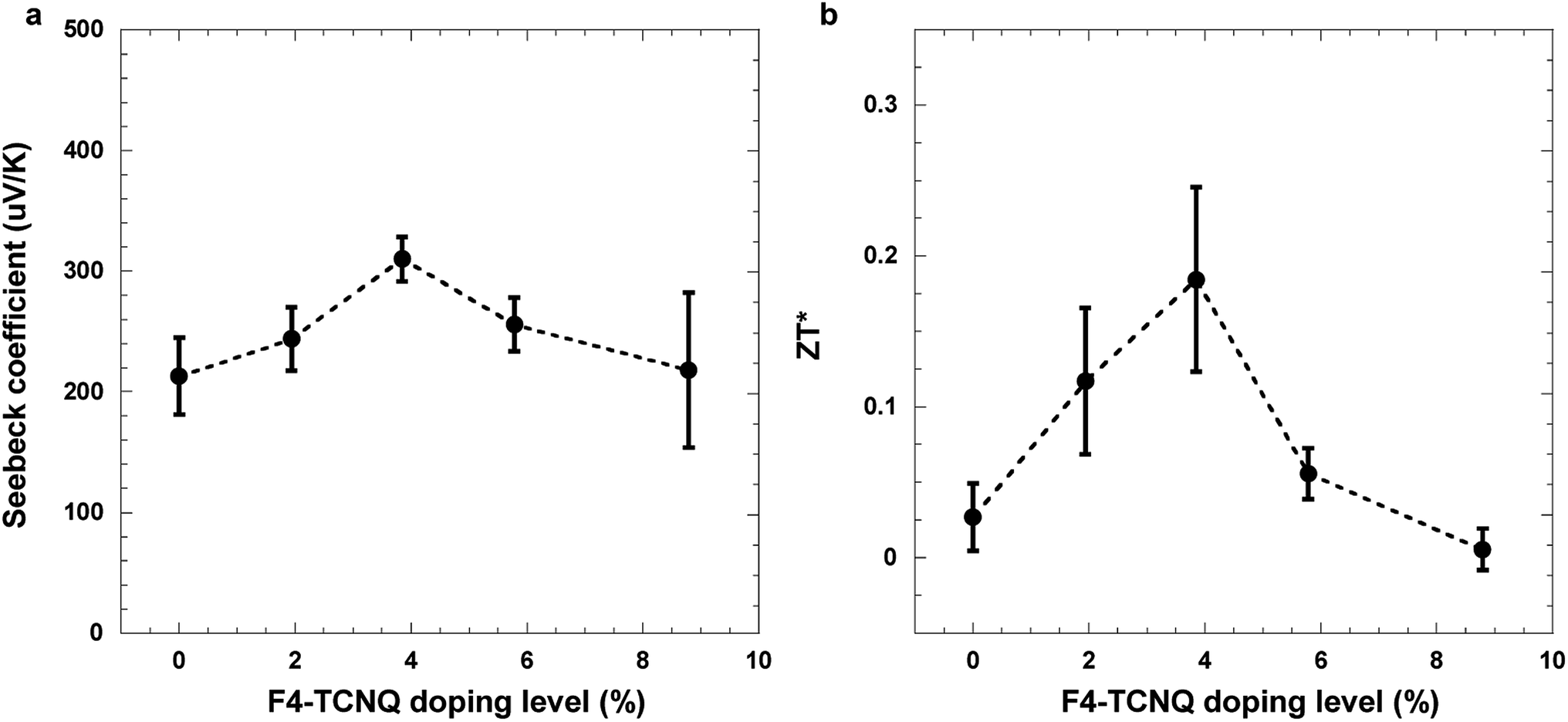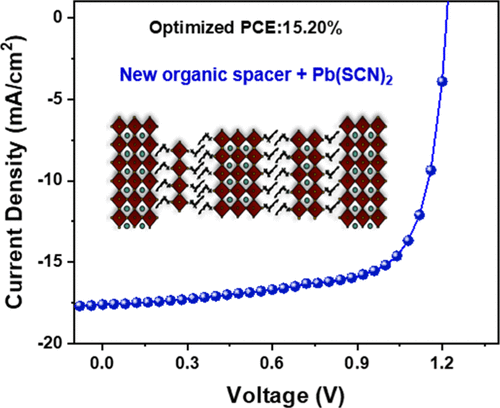The Xiong Gong Group has recently published three articles featured in the Journal of Materials Chemistry A, ACS Applied Electronic Materials, and ACS Applied Materials & Interfaces. Their work has been reported in a series of twenty peer-reviewed articles in 2020. Read and learn more about their research below.
Enhanced thermoelectric performance of F4-TCNQ doped FASnI3 thin films
 In the past decade, great efforts have been devoted to the development of organic–inorganic hybrid perovskites for achieving efficient photovoltaics, but less attention has been paid to their thermoelectric applications. In this study, for the first time, we report the thermoelectric performance of 2,3,5,6-tetrafluoro-7,7,8,8-tetracyanoquinodimethane (F4-TCNQ) doped NH2CHNH2SnI3 (FASnI3) thin films. It is found that the electrical conductivities of the F4-TCNQ doped FASnI3 thin films increase and then decrease along with increased doping levels of F4-TCNQ. Systematic studies indicate that enhanced electrical conductivities are attributed to the increased charge carrier concentrations and mobilities and superior film morphologies of the F4-TCNQ doped FASnI3 thin films, and decreased electrical conductivities originate from the cracks and poor film morphology of the F4-TCNQ doped FASnI3 thin films induced by excess F4-TCNQ dopants. The quantitative thermal conductivity scanning thermal microscopy studies reveal that the F4-TCNQ doped FASnI3 thin films exhibit ultralow thermal conductivities. Moreover, the thermoelectric performance of the F4-TCNQ doped FASnI3 thin films is investigated. It is found that the F4-TCNQ doped FASnI3 thin films exhibit a Seebeck coefficient of ∼310 μV K−1, a power factor of ∼130 μW m−1 K−2 and a ZT value of ∼0.19 at room temperature. All these results demonstrate that our studies open a door for exploring cost-effective less-toxic organic–inorganic hybrid perovskites in heat-to-electricity conversion applications at room temperature. Click here for more details.
In the past decade, great efforts have been devoted to the development of organic–inorganic hybrid perovskites for achieving efficient photovoltaics, but less attention has been paid to their thermoelectric applications. In this study, for the first time, we report the thermoelectric performance of 2,3,5,6-tetrafluoro-7,7,8,8-tetracyanoquinodimethane (F4-TCNQ) doped NH2CHNH2SnI3 (FASnI3) thin films. It is found that the electrical conductivities of the F4-TCNQ doped FASnI3 thin films increase and then decrease along with increased doping levels of F4-TCNQ. Systematic studies indicate that enhanced electrical conductivities are attributed to the increased charge carrier concentrations and mobilities and superior film morphologies of the F4-TCNQ doped FASnI3 thin films, and decreased electrical conductivities originate from the cracks and poor film morphology of the F4-TCNQ doped FASnI3 thin films induced by excess F4-TCNQ dopants. The quantitative thermal conductivity scanning thermal microscopy studies reveal that the F4-TCNQ doped FASnI3 thin films exhibit ultralow thermal conductivities. Moreover, the thermoelectric performance of the F4-TCNQ doped FASnI3 thin films is investigated. It is found that the F4-TCNQ doped FASnI3 thin films exhibit a Seebeck coefficient of ∼310 μV K−1, a power factor of ∼130 μW m−1 K−2 and a ZT value of ∼0.19 at room temperature. All these results demonstrate that our studies open a door for exploring cost-effective less-toxic organic–inorganic hybrid perovskites in heat-to-electricity conversion applications at room temperature. Click here for more details.
All-Solid-State Asymmetric Supercapacitors with Novel Ionic Liquid Gel Electrolytes
 In the past years, all-solid-state supercapacitors, as energy storage devices, have drawn greatest attention in both academic and industrial sectors because of their potential applications, in particular in the wearable and portable electronics. However, poor energy densities of all-solid-state supercapacitors restrict their practical applications. In this study, we first report novel ionic liquid gels composed of poly(vinyl alcohol) (PVA), 1-butyl-3-methylimidazolium tetrafluoroborate (BMIMBF4), and tetrabutylammonium tetrafluoroborate (TBABF4) (PVA:BMIMBF4:TBABF4) as the solid-state electrolytes. It is found that the PVA:BMIMBF4:TBABF4 solid-state electrolytes exhibit dramatically enhanced ionic conductivity. Afterward, we report all-solid-state asymmetric supercapacitors (ASCs) by using MnO2 coated on a carbon cloth (CC) as the positive electrode, reduced graphene oxide coated on a CC as the negative electrode, and novel PVA:BMIMBF4:TBABF4 as the solid-state electrolyte. All-solid-state ASCs exhibit an operational window of 3 V, an energy density of 61.2 W h/kg at the power density of 1049 W/kg, and more than 80% capacitance retention after 3000 charge/discharge cycles. All these results demonstrate that we provide a facile way to develop high-energy-density all-solid-state ASCs with good cycling stability. Click here for more details.
In the past years, all-solid-state supercapacitors, as energy storage devices, have drawn greatest attention in both academic and industrial sectors because of their potential applications, in particular in the wearable and portable electronics. However, poor energy densities of all-solid-state supercapacitors restrict their practical applications. In this study, we first report novel ionic liquid gels composed of poly(vinyl alcohol) (PVA), 1-butyl-3-methylimidazolium tetrafluoroborate (BMIMBF4), and tetrabutylammonium tetrafluoroborate (TBABF4) (PVA:BMIMBF4:TBABF4) as the solid-state electrolytes. It is found that the PVA:BMIMBF4:TBABF4 solid-state electrolytes exhibit dramatically enhanced ionic conductivity. Afterward, we report all-solid-state asymmetric supercapacitors (ASCs) by using MnO2 coated on a carbon cloth (CC) as the positive electrode, reduced graphene oxide coated on a CC as the negative electrode, and novel PVA:BMIMBF4:TBABF4 as the solid-state electrolyte. All-solid-state ASCs exhibit an operational window of 3 V, an energy density of 61.2 W h/kg at the power density of 1049 W/kg, and more than 80% capacitance retention after 3000 charge/discharge cycles. All these results demonstrate that we provide a facile way to develop high-energy-density all-solid-state ASCs with good cycling stability. Click here for more details.
Novel Quasi-2D Perovskites for Stable and Efficient Perovskite Solar Cells
 Compared to three-dimensional (3D) organic–inorganic hybrid perovskites, two-dimensional (2D) ones possess great possibilities to realize stable cost-effective perovskite solar cells (PSCs). However, studies indicated that PSCs with 2D perovskites exhibited poor power conversion efficiencies (PCEs). In this study, we report novel propargylamine cation (PPA+)-based quasi-2D perovskites. PPA+ employed as an organic spacer is for enhancing charge-carrier transport of quasi-2D (PPA)2(CH3NH3)2Pb3I10 thin films, consequently boosting PCEs of PSCs. To further boost PCEs of PSCs with quasi-2D (PPA)2(CH3NH3)2Pb3I10 thin films, a quasi-2D (PPA)2(CH3NH3)2Pb3I10 thin film is processed with Pb(SCN)2 additives. Systematical studies indicate that the quasi-2D (PPA)2(CH3NH3)2Pb3I10 thin film processed with Pb(SCN)2 additives exhibits superior film morphology and crystallinity, larger crystals, reduced nonradiative charge-carrier recombination, and enhanced and balanced charge-carrier mobilities compared to the pristine quasi-2D (PPA)2(CH3NH3)2Pb3I10 thin film. As a result, PSCs with the quasi-2D (PPA)2(CH3NH3)2Pb3I10 thin film processed with Pb(SCN)2 additives exhibit a PCE of 15.20%, which is an over 25% enhancement compared to those (12.16%) with a pristine quasi-2D (PPA)2(CH3NH3)2Pb3I10 thin film. In addition, PSCs with the quasi-2D (PPA)2(CH3NH3)2Pb3I10 thin film processed with Pb(SCN)2 additives possess dramatically suppressed photocurrent hysteresis and significantly boosted stability. All these results indicate that we have developed a facile way to synthesize novel 2D perovskite thin films for realizing stable and efficient PSCs with dramatically suppressed photocurrent hysteresis. Click here for more details.
Compared to three-dimensional (3D) organic–inorganic hybrid perovskites, two-dimensional (2D) ones possess great possibilities to realize stable cost-effective perovskite solar cells (PSCs). However, studies indicated that PSCs with 2D perovskites exhibited poor power conversion efficiencies (PCEs). In this study, we report novel propargylamine cation (PPA+)-based quasi-2D perovskites. PPA+ employed as an organic spacer is for enhancing charge-carrier transport of quasi-2D (PPA)2(CH3NH3)2Pb3I10 thin films, consequently boosting PCEs of PSCs. To further boost PCEs of PSCs with quasi-2D (PPA)2(CH3NH3)2Pb3I10 thin films, a quasi-2D (PPA)2(CH3NH3)2Pb3I10 thin film is processed with Pb(SCN)2 additives. Systematical studies indicate that the quasi-2D (PPA)2(CH3NH3)2Pb3I10 thin film processed with Pb(SCN)2 additives exhibits superior film morphology and crystallinity, larger crystals, reduced nonradiative charge-carrier recombination, and enhanced and balanced charge-carrier mobilities compared to the pristine quasi-2D (PPA)2(CH3NH3)2Pb3I10 thin film. As a result, PSCs with the quasi-2D (PPA)2(CH3NH3)2Pb3I10 thin film processed with Pb(SCN)2 additives exhibit a PCE of 15.20%, which is an over 25% enhancement compared to those (12.16%) with a pristine quasi-2D (PPA)2(CH3NH3)2Pb3I10 thin film. In addition, PSCs with the quasi-2D (PPA)2(CH3NH3)2Pb3I10 thin film processed with Pb(SCN)2 additives possess dramatically suppressed photocurrent hysteresis and significantly boosted stability. All these results indicate that we have developed a facile way to synthesize novel 2D perovskite thin films for realizing stable and efficient PSCs with dramatically suppressed photocurrent hysteresis. Click here for more details.
